Introduction
Indian mural paintings, spanning various regions and historical periods, exhibit diverse themes, styles, and techniques. From Ajanta and Ellora to Kerala’s temple murals, they reflect India’s rich artistic heritage.
Description of Mural Painting

- Time Period: India has a rich history of murals dating from the 10th century BC to the 10th century AD.
- Meaning: Murals are basically artworks created on solid structures or walls.
- The process of making Indian wall paintings is described in a special chapter of the Vishnudharamotaram, a Sanskrit text from the 5th to 6th century AD.
- Vinaya Pitaka: Mentions pleasure houses with picture halls adorned with painted figures and decorative patterns.
- It also mentions the Ajanta Paintings of Maharashtra.
Enroll now for UPSC Online Course
Locations
- Prominent locations: Ajanta, Armamalai Cave & Sittanavasal Caves (Tamil Nadu), Ravan Chhaya Rock Shelter (Odisha), Bagh Caves (Madhya Prasdesh), and Kailasha Temple in Ellora.
- Other Locations: Anantha at Anantha Padmanabha Temple in Kasargod; Shiva’s pursuit of a boar in a scene from Kiratarjuniya at Lepakshi Temple; Chola king Rajaraja and court poet Karuvar Dever in Thanjavur, eleventh century; Shiva killing Tripuraasura in Thanjavur; Rama’s defeat of Ravana in a scene from the Ramayana panel at Mattancheri Palace and Shasta at Padmanabhapuram Palace in Thakkala.
Conclusion
- Indian mural paintings represent a vibrant tapestry of artistic expression, cultural traditions, and historical narratives, serving as enduring legacies of creativity and craftsmanship across different periods and regions of India.
![]() April 20, 2024
April 20, 2024
![]() 1236
1236
![]() 0
0
